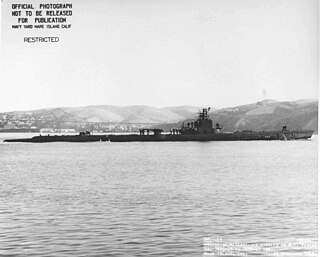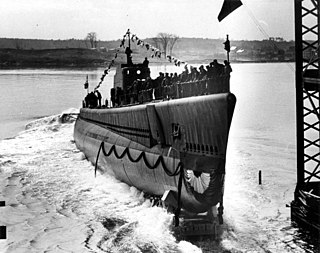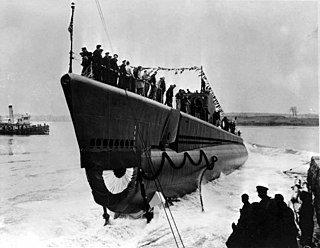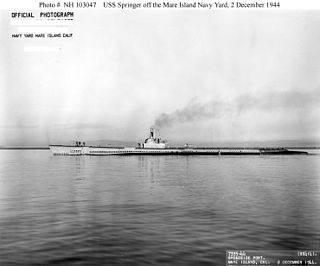
USS Gato (SS-212) was the lead ship of her class of submarine in the United States Navy. She was the first Navy ship named for the common name used for a number of species of catshark. She was commissioned only days after the declaration of war and made thirteen combat patrols during World War II. She survived the war and spent the post-war period as a training ship before being sold for scrapping in 1960.

USS Stickleback (SS-415), a Balao-class submarine, was named for the stickleback, a small scaleless fish.

USS Tilefish (SS-307), a Balao-class submarine, was the only ship of the United States Navy to be named for the tilefish, a large, yellow-spotted deepwater food fish.

USS Gar (SS-206) was the first of the Gar subclass of the Tambor-class submarines to be commissioned for the United States Navy just prior to the country's 7 December 1941 entry into World War II. These submarines were a slightly improved version of preceding submarines of the Tambor class. While Gar survived the war, all of her sister ships — USS Grampus (SS-207), 'USS Grayback (SS-208), USS Grayling (SS-209), USS Grenadier (SS-210), and USS Gudgeon (SS-211) — were lost. She is the only ship of the United States Navy to be named for the gar, a fish of the family Lepisosteidae.

USS Sand Lance (SS-381), a Balao-class submarine, was the first ship of the United States Navy to be named for the sand lance, a member of the family Ammodytidae.

USS Pipefish (SS-388/AGSS-388), a Balao-class submarine, was the only ship of the United States Navy to be named for the pipefish.

USS Scabbardfish (SS-397), a Balao-class submarine, was the only ship of the United States Navy to be named for the scabbarddfish, a long, compressed, silver-colored fish found on European coasts and around New Zealand. In 1965 she was transferred to the Hellenic Navy and renamed Triaina.

USS Toro (SS-422), a Tench-class submarine, was the only ship of the United States Navy to be named for the toro, a name applied to various fish including the cowfish, the catalufa, and the cavallo.

USS Kingfish (SS-234), a Gato-class submarine, was the first ship of the United States Navy to be named for the kingfish.

USS Shad (SS-235), a Gato-class submarine, was the first submarine and second vessel of the United States Navy to be named for the shad, a fish of the herring family, common along coasts of the United States.

USS Muskallunge (SS-262), a Gato-class submarine, was a ship of the United States Navy named for the muskallunge.

USS Pogy (SS-266), a Gato-class submarine, was the first ship of the United States Navy to be named for the pogy, or menhaden. She was credited with sinking 16 ships totaling 62,633 gross register tons during World War II.

USS Steelhead (SS-280), a Gato-class submarine, was a ship of the United States Navy named for the steelhead, a North American trout found from California to Alaska.

USS Devilfish (SS/AGSS-292), a Balao-class submarine, was a ship of the United States Navy named for the devil fish.

USS Hackleback (SS-295), a Balao-class submarine, was a ship of the United States Navy named after the hackleback, a freshwater fish of the sturgeon family.

USS Seahorse (SS-304), a Balao-class submarine, was the first submarine and second ship of the United States Navy to be named for the seahorse, a small fish whose head and the fore part of its body suggest the head and neck of a horse.

USS Pilotfish (SS-386), a Balao-class submarine, was a ship of the United States Navy named after the pilot fish, a carangoid fish, often seen in warm latitudes in company with sharks.

USS Segundo (SS-398) was a Balao-class submarine, of the United States Navy named for the segundo, a cavalla fish of Caribbean waters.

USS Spikefish (SS/AGSS-404), a Balao-class submarine, was a ship of the United States Navy, named for the spikefish. She was the first United States submarine to record 10,000 dives.

USS Springer (SS-414) was a Balao-class submarine of the United States Navy, named after the springer, a Grampus.





















